Menus
- Horse of three !
- The Can-Am Spyder, an astonishing automobile front-end trike, is celebrating its 5th anniversary this year. The opportunity for us to try out both versions, the new sporty RS-S variant and its Grand Touring RT variant. Follow the leader….
- Discovery
- RS and RT versions
- In the saddle
- In the city
- Motorways and expressways
- Departmental
- Braking
- Comfort / Duo
- Sequential transmission
- Conclusion
- RS version
- RT version
Horse of three !
The Can-Am Spyder, an astonishing automobile front-end trike, is celebrating its 5th anniversary this year. The opportunity for us to try out both versions, the new sporty RS-S variant and its Grand Touring RT variant. Follow the leader….
Let’s start with the presentations. Can-Am is a brand of the BRP group, acronym for Bombardier Recreational Products (or “recreational products” in our case). BRP also produces snowmobiles (Ski-Doo, Lynx), boats and personal watercraft (Sea-Doo), outboard motors (Evinrude, Jonhson) and general motors (kart, planes and motorcycles) under the Rotax label. . In short, BRP is THE specialist in toys for adults. And until 2007, the Canadian group did not have a product dedicated to road use. Of course, Can-Am was already producing off-road quads approved for road use, but we must not mix the tea towels with the towels…. The only thing is, at Bombardier, we don’t like to be like everyone else. Logically, when we invented the snowmobile, the personal watercraft (or jet ski) and the pile of prizes and awards garnered over the years looks like a directory, we have to innovate! This is how BRP has developed a unique vehicle of its kind, a cross between a motorcycle and an automobile, from which it uses the configuration of the front axle, or according to our colleagues from across the Atlantic, a road version of the famous Ski-Doo. . This “Y” configuration of the running gear will also inspire its trade name of SPYDER when it was launched in 2008. The Spyder RS version was then supported in 2010 by an RT version, oriented Touring.

Discovery
The Spyder RS and RT are both based on the same engine chassis assembly. The frame, made of rectangular-section steel tubes, encloses an old acquaintance, the V2 998 cm3 Rotax open at 60 ° which until recently fitted the Aprilia RSV. It is here reconfigured to deliver originally 106 horsepower at 8,500 rpm and 104 Nm of torque at 6,250 rpm on the RS version. As for the RT version, grand touring requires, the power drops to 100 hp at 7,500 rpm but the torque climbs to 108 Nm and is available from 5,000 rpm. Two types of transmissions are available: a manual with clutch and foot control and a robotic variation with handlebar control. Regardless of the version, there are only five gears, the sixth being replaced by a reverse gear. The final transmission is supported by a maintenance-free belt as found on Harley-Davidson. Braking is provided at the front by two 250mm diameter discs clamped by 4-piston calipers. At the rear, the disc is the same diameter, but the caliper is a single piston. The double wishbone front axle fits 165/65 wheels in 14 inches, the grip of the rear axle (a swing arm as long as an Adriana Carembeu leg) is entrusted to a 225/50 mounted on a 16 inch rim. Like an automobile, the Can-Am Spyder is packed with electronic aids. In addition to power steering, the driver assistance system developed by Bosch combines ABS, traction control and stability control. Finally, note that while the space under the seat is taken up by the 25-liter tank, a 44-liter trunk is concealed in the nose of the Spyder..
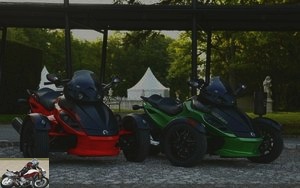
RS and RT versions
So much for the common core, but the RS and RT versions remain radically different by their respective placements. The stripped-down Spyder RS weighs “only” 317 kg dry when its GT counterpart has 421, the weight of a Honda Goldwing. This overweight comes from multiple frame reinforcements, a more protective trim and a specific rear portion incorporating a passenger backrest, a top-case and two side cases. In addition to an increased load capacity from 44 to 155 liters, an imposing electrically operated windshield, cruise control and heated grips are part of the original package. The high-end versions are also equipped with equipment worthy of the Goldwing mentioned above: GPS, front rear audio system with separate volume controls, electrically adjustable rear suspension, iPod connection, trunk opening by remote control, electric parking brake ….
In the saddle
Can-Am invited us to test its RS and RT models on the occasion of its third annual European gathering, held this year in Auvergne, on the site steeped in the history of the Charade circuit and its surroundings. We had at our disposal Spyder RS-S, with a specific aesthetic treatment and a pair of Fox shocks firmed up at the front, and RT in Limited version "full option".
On the RS-S, the stance is clearly sporty with the requirement to lean the torso forward to catch a relatively narrow handlebar. The dashboard has a liquid crystal screen with digital display indicating speed, rpm, gear engaged, odometer, two trips, the time as well as the remaining range, all framed by a tachometer and a counter of speed. The footrests, vertical to the posterior, induce a bent leg position without too much excess ….
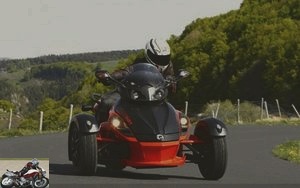
On RT, we are more relaxed. The saddle, thicker, unfolds the legs a few centimeters and the handlebars are both higher and significantly wider. The visual world is also more cluttered with the control for the radio, that of the windshield and the gearshift paddles on the left stalk. On the right is a cruise control and a whole battery of buttons (parking brake, suspensions….) Occupies a console at the base of the handlebars. On the other hand, the right grip is devoid of any lever, braking being provided by a single pedal on the right foot..
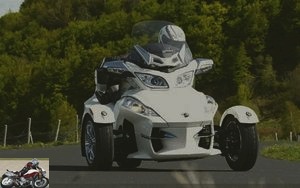
To start, you must follow a specific procedure, namely pressing a (another) commodo on the handlebars after switching on the ignition. By pressing the said button, the pilot implicitly signals that he has read the operating instructions and that he has carried out the checklist hidden in a plastic tab located above the dashboard (very similar to that recommended on a motorbike for those who have read theirs….). But then why the button? And why at each start? For the Can-Am Canadians, this starting procedure is considered “normal”. But it must be said that in North America, people are a bit litigious and quickly demand tens of millions of dollars from anyone whenever something goes wrong. It was these kinds of procedures that ended the career of another three-wheeler, the ATC (ancestor of the quad) after an avalanche of lawsuits at Uncle Sam against the manufacturers ….
In the city
The first few miles on the Spyder RS-S are quite confusing, with a ride close to that of a quad. With the machine turning flat, constant pressure should be applied to the handlebars. Except that the direction seems multiplied (the wheels turn more than the handlebars) which induces at the start some untimely zig-zag on the road. Once these parameters are integrated, the RS-S can gradually be tamed. To have driven in concert with other journalists, including non-bikers, (the Spyder is accessible to holders of license A), the grip is easier for non-bikers while for bikers, the time to adaptation takes longer. Obviously, the biker has preconceptions and habits on the handlebars and the Spyder is not a motorcycle at all..
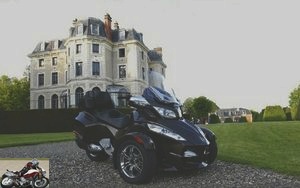
Fortunately, the V2 in this deflated version is at ease in the city. Both flexible and torquey from the lowest speeds, the Rotax resumes from 2000 rpm on 5th gear (45 km / h) without hiccuping and can be assisted by a clutch as soft as it is progressive if necessary. For the rest, the city’s exercise is very “automotive-like” given the width of the Spyder. Including the passable turning radius, which will require the use of reverse gear to make a U-turn on a two-lane. Paradoxically, the RT version is doing the best in this exercise. Despite the additional 100 kg, the effort on the handlebars is less than on the RS and the filtering of the suspensions is much more convincing to swallow the speed bumps or simply to ride on degraded asphalt. In addition, the RS when heated returns its calories to the rider’s ankle and right calf. The phenomenon, anecdotal with boots, could cause discomfort if we are satisfied with a simple pair of sneakers.
Motorways and expressways
As soon as the horizon clears, Spyder RS and RT reveal the relevance of their concept. The protection offered by the RT version is worthy of a BMW K 1600 GT once the bubble screen is correctly adjusted. While the front suspensions could be a little less firm and offer a little more travel to really compete with the cream of GT motorcycles but the softness of the saddle more than compensates for this small handicap..
Logically, the RS does less well in this area, but the protection offered by the small screen makes it possible to cruise without difficulty at 140 km / h and the front axle fairing assembly effectively protects the entire lower body in bad weather. If necessary, an XXL version is available as an option.
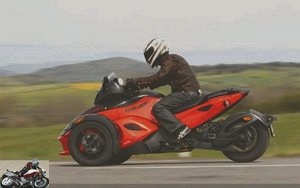
At 130 km / h, the engine runs at 5,900 rpm (red zone starting at 9,000 rpm), which is right in the engine’s optimum operating range. Suddenly, raises and overtaking are particularly energetic despite the weight of the machines. On the other hand, the five gears of the gearbox put a strain on fuel consumption and range, and we come to regret the presence of an overdrive-type sixth. Consumption can fall below the 7l / 100 km mark with the help of cruise control (on the RT), but you can easily exceed the 8-liter mark as soon as you abuse the right handle a little, dropping the range below 300 kilometers.
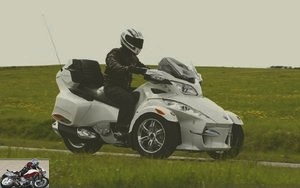
Departmental
When you see the ground contact area offered by the three huge tires, you imagine that the Spyder RS must be a weapon on departmental. Unfortunately, we will stick to the economic situation because electronics very quickly curb any sporting ambitions. And a little brutally too…. Entering a corner too fast instantly activates the stability control which can act independently on the ignition or the brakes. On a corner that is closing, over-steer can even trigger both at the same time. Very safe operation for the motorist and frustrating for the biker who appreciates the curves and the knee in the bends! No problem, we tell ourselves that we will take advantage of the traction to come out like a bullet from the turn…. No more ! The arrival of power is conditioned (among other things) by the steering angle. Morality, the more the turn is tight, the more the bridle is important. The condition of the bitumen also has a direct influence on performance. The more it is degraded, the more it will harm the suspensions and will tend to trigger the stability control in an untimely manner..
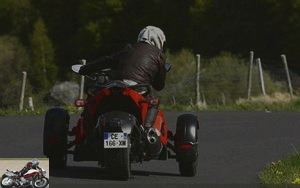
It is understandable that Can-Am wants to protect itself from the excesses of certain drivers (see the lawsuits cited above), especially since the proliferation of driving aids is a strong marketing argument to attract motorists. But for a motorcyclist more eager for sensations than for safety, these electronic crutches will be able to cause a certain frustration…. That said, after a few kilometers, you end up understanding how the system works and you adapt your driving accordingly. In order not to panic the electronics, you have to drive with finesse and wiggle your hips to carry the maximum weight on the inside wheel. This “quad” position also saves the pilot because, between the centrifugal force and the obligation to exert constant pressure on the handlebars in the bends, riding other than at a senator’s pace on departmental roads can quickly s. prove tiring. But, to use the old expression, it is possible to roll drum beating in "trajectory to death". Note that the Spyder’s performance remains directly linked to the profile of the road, the ideal playing field being medium curves with constant radius. There, we can take advantage of the full potential of the Spyder and even give a hard time to a classic vehicle..
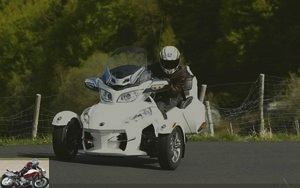
And the RT? Despite his extra quintal, he is doing quite well in the exercise. With its supple suspensions, it needs a slight response time before it “locks” onto its outside wheel in the corners, but the stability control seems to work more smoothly here. And the large handlebars make the exercise less physical than with the RS. In short, since Can-Am does everything to encourage you to stroll, you might as well choose the RT.
Braking
There is also a good thing in Can-Am’s sur-safety philosophy. Because the braking potential of the Spyder RS is simply mind-blowing. Crushing the brake pedal in a straight line to simulate an emergency stop feels like the Can-Am is literally stuck in the road. Better, this phenomenal power does not come at the expense of progressiveness, with a sensitivity perfectly measured on the first few centimeters of the pedal. It is even possible to brake hard in the middle of a turn. Be careful, however, this maneuver should be reserved for emergencies. Because if the RS-S reacts perfectly on billiards, too much stress on rough roads can make the Spyder unstable, even with the help of electronic crutches. The RT version is logically a step below in pure power due to its overweight but the whole remains very reassuring.
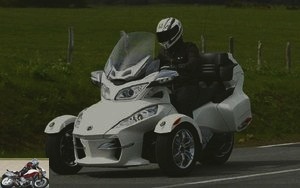
Comfort / Duo
No problem with the RT. The wide rear backrest, very enveloping, will prevent the passenger from having to constantly hang on to the side handles when cornering. It will be much more physical with the RS for the sandbag as soon as the road starts to turn. Fortunately, there is an optional backsplash, also enveloping, to consider long journeys … And if the comfort of the RT has already been mentioned a little above, that of the RS-S and also in the good average.
Sequential transmission
The electronic sequential gearbox, dubbed SE5, is very convincing. Very gentle in the start-up phases, it leaves the pilot free to upshift when he wants, intervening automatically only to downshift a gear in the event of under-revving (2,000 rpm). By pushing on the "-" trigger, the electronics even take care of putting on the right little throttle in order to engage the lower gear without the shadow of a sudden. Shifting is just as smooth under light load. In full acceleration on the other hand, it is imperative to relieve the right handle to accompany the change of report..
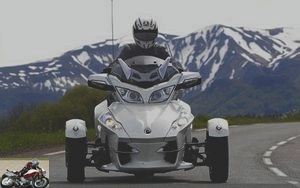
Conclusion
The Spyder is more like a car than a motorcycle, offering the outward feel of a motorcycle without the lean angles. This criticism can also be made with regard to sidecars and other trikes. Can-Am does not claim any technical advantage over a more traditional means of transport. Like all machines produced by BRP, the Spyder is a pure "recreational product" and should not be viewed with the same expectations, especially as that of a motorcycle. On the other hand, it is a real different product, available to any motorist without passing the motorcycle license who would like to buy a big toy and go on the road with it..
Some purist bikers may look for the interest of the RS version, whose limited versatility, could confine it to Sunday walks and possibly to cafe terraces (if you find a wide enough sidewalk). The RT on the other hand is a concept as successful as it is relevant and arises as a more than credible alternative to a classic GT. In either case, any sporting dimension must be excluded from the equation. Because the driving assistance, which cannot be disconnected, risks spoiling your pleasure. This precision made, the Spyder (s) exudes its share of sensations and even a certain driving pleasure. The performance in a straight line or even in a large curve is also of an excellent level compared to that of an automobile.
The RS and RT also admit respective weight / power ratios of 3.8 and 4.9, the equivalent of a BMW M5 V10 and a Porsche 997. Enough to panic the thrilling and provide its share of sensations. As for the look, it will not leave anyone indifferent. Few vehicles get so much attention. A mother in a minivan even went so far as to cause a traffic jam to find out about our strange mounts ….
There remains the question of price. An RS in manual transmission costs € 16,499, its RS-S version € 17,999, and the sequential transmission results in an additional cost of € 2,500. As for the RT, available in no less than 5 versions, the entry level starts at € 21,499 and a full option model rises to € 28,999, or a price equivalent to that of a Honda 1800 Goldwing. If you can’t figure it out, your best bet is to give it a try. Unlike some motorcycle dealers, Can-Am dealerships are very open on the subject ….
RS version
Strong points
- Braking
- Out-of-the-ordinary look
- Correct performance
Weak points
- Intrusive and non-disconnectable electronics
- Limited versatility
RT version
Strong points
- Protection
- Braking
- Equipment
- Carrying capacity
Weak points
- Intrusive and non-disconnectable electronics
- Autonomy
Datasheet
Related articles
-
The Touring sporty version … or the other way around… After the RT and especially the Spyder F3-S, Can-Am returns with a new three-wheel model placed…
-
Sporty motorbike or three-wheeler A bomber…. in every sense of the term. Because the Can-Am Spyder is a pure recreational product signed by BRP, for…
-
Seriously wanton ! The BMW S 1000 R, the “string and tall handlebar” version of its in-house superbike, has strong arguments to make a place for itself…
-
Triumph Street Triple 765 RS test: the right number
Numerology French bikers are difficult, some would say. False, shall we say. They are experienced amateurs who prioritize quality and performance. This…
-
Parallel twin, 798 cm3, 48 hp at 6,750 rpm, 69 Nm at 3,500 rpm, 214 kilos, from € 11,000 A small efficient and versatile truck accessible to young…
-
The school of fans (of speed) KTM hits hard with its RC 390 by offering the most efficient machine in the A2 segment. Easy and fun while remaining very…
-
Sneackers racer The rise of motorcycles known as classics , neo-retro or vintage could not have escaped your notice. These kinds of machines are all the…
-
Vespa GTS 300 Touring scooter test
Hornet of cities and fields What is most like a Vespa GTS? another Vespa GTS! The formula seems to be obvious but not so much as the scooter exists in a…
-
The three-wheeler accessible in its 600 and 900 Rotax versions Should we still present the or rather the Can-Am, especially in France, which represents…
-
Piaggio MP3 500 LT ie scooter test
MP3 … Piaggio never stops offering its flagship three-wheeler in all possible displacements and variations, business included. In the LT version (Large…